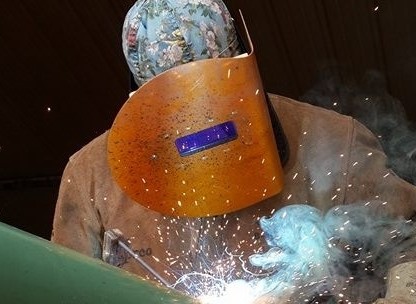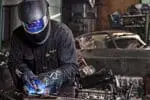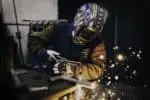Sparks and flames are the primary concerns when welding. But, that’s certainly not all, especially, for pipeline welders who work outdoors.
The biggest constraint while working outdoors is the glare that is a result of the Sunlight coming from behind.
Traditional welding helmets might not always protect from glare when the Sun is behind, blinding you temporarily. And compromised vision even for a fraction of a second is enough to deteriorate the quality of work.
Pancake hoods are the best welding helmets since their design and structure are made while keeping this constraint in mind: glare due to sunlight that escapes inside a traditional welding helmet.
A pancake hood has a Balsa box fitted on the inside of the helmet. It’s customized so that it holds the welding lenses in place. As a result, sunlight, no matter how bright, doesn’t blind welders.
Balsa box is, thus, the secret feature that makes pancake hoods very practical options for outdoor welding or welding where you’ve got to keep the metal very close to your face.
Keep reading to find out more details about pancake hoods and their popularity amongst beginners and well as pro welders.
What is a pancake welding hood?
Eyes are at the most risk when welding. Keeping this constraint in mind, innovative helmet designs are launched every now and then.
Surprisingly, pancake hoods that are getting more and more popular for outdoor welding are actually almost a century old.
They have been improved from the original models though. Putting it simply, a pancake welding hood can be called an innovative welding mask, a headgear, or a helmet.
It has a big, round, and thin welding disc in the front and a shield either on the left side or the right side (the version you buy should depend on whether you’re a right-handed welder or a left-handed welder).
There’s a Balsa box that’s fitted behind the disc and stacked against the shield. The purpose of this box is to hold the welding lenses at places. There’s no gap left because most Balsa boxes are handmade so that they can adhere to the exact measurements of the welder’s face.
The reasons that Balsa wood is used to make this box are:
-
-
- Wood is a very bad conductor of electricity.
- Balsa wood is super lightweight.
-
Why do pipeline welders wear pancake helmets?
When working outside, the time close to sunrise and sunset can be very upsetting for welders – wondering why?
Well, when pipeline welders are working outside, the Sunlight from behind produces a very strong glare that, despite wearing helmets, gets reflected. The glare can be so strong that many welders get temporarily blinded.
Naturally, a lag of any amount ruins the quality of the weld. Also, it’s dangerous for the hands and otherwise.
This constraint is taken care of in pancake hoods. The Balsa box offers perfect contouring. It doesn’t let sunlight affect vision at all. Hence, pancake hoods are practical solutions for pipeline welders.
Types of pancake hoods – what’s the role of a Balsa box?
Pancake hoods are of two types: pancake hoods with a shield on the right side and a pancake hood with a shield on the left side. Balsa box is the secret ingredient behind the popularity of pancake hoods amid welders.
It’s a lightweight box that’s made from Balsa wood. Despite being hardwood, Balsa is economical and easy to carve. It can be properly sanded to hold the welding lenses without leaving any gaps.
Also, since it is comfortably sanded, there’s no pressure around the pressure points. Because the lenses are held properly in place, the eyes are properly masked from bright light and sparks.
Top 5 advantages of pancake hoods that you must know
#1 It is Lightweight and breathable
The shield, disc, and Balsa box are non-bulky. Besides, since the pancake hood is not an entirely enclosed headgear, it also allows the flow of air. Hence, it keeps the welders cool.
#2 It Does not compromise vision
Eliminating glare from the Sun is the very first way in which a pancake hood keeps the vision on point. Other than that, the Balsa box eliminates fogging of the welding lens as well. Thus, you’ll be able to see very clearly while welding.
#3 It Protects from fumes, flames, and UV rays
The disc on the front and the shield on the side don’t allow UV rays or fumes to get in direct contact with the welder.
The disc and the shield also block sparks, bright light, blue light, and flames. Fumes cannot penetrate at all. Hence, a pancake hood protects the eyes and face of the welders.
Whenever welding is being done from weird angles, the Balsa box holds the welding lenses in place. Hence, the eyes are properly shielded and the vision isn’t compromised at all.
#4 It is comfortable to wear for long working hours
Welding helmets are bulky. Whether they’re battery-operated or Solar-powered, they aren’t feather-light. But a pancake hood is.
When you have to weld for a long time, a pancake hood will keep you comfortable because:
-
-
- It won’t exert pressure on the forehead or the sides of the ears.
- Its open design will keep you cool.
- The Balsa box is properly sanded. Hence, it won’t hurt either.
-
#5 It fits well because it is mostly customized
This is one of the most distinctive features of a pancake hood that sets it apart from most other welding helmets: it’s handmade.
Hence, the Balsa box fits the contours around the eyes and nose perfectly.
Pancake Welding Hoods Vs Welding Helmets – 3 Key Differences!
Some people might say that pancake hoods can only be used outdoors. But, that’s not true. They are also used for indoor welding; especially stick welding where the metal being welded creates a lot of sparks and spatter and is held very close to the face.
So, indoor welding and outdoor welding cannot be used as a ground to differentiate pancake hoods from welding helmets. The three major differences that set the two apart are as follows.
1.) Weight – It’s easy and comfortable to wear a pancake hood for a long time because it’s lightweight. A welding helmet, on the other hand, is heavier.
2.) Comfort – First of all, a pancake hood will keep you much cooler while welding than a welding helmet can. Besides, the Balsa box properly grips the lens.
Thus, the lens doesn’t wobble and there’s no pressure exerted around the ears.
3.) Clarity – Pancake hoods are practical solutions that block all the light coming from behind. Hence, there’s no glare. On the other hand, this comfort doesn’t exist in welding helmets.
Secondly, fogging that can be an issue with welding helmets is easily taken care of by pancake hoods.
FAQs
1.) Can you wear a pancake hood with a hard hat?
No. Pancake hoods cannot be worn with a hard hat. The Balsa box is already compact. So, there’s practically no space for the hard hat.
2.) Why are pipeline helmets different?
Pipeline helmets or pancake hoods block light coming from behind. Hence, they’re different.
Concluding Thoughts:
Welders wear pancake hoods because pancake hoods are the only masks that can REALLY block sunlight coming from behind. Besides, they have a folded ear guard design that makes them very comfortable to wear.
Another very interesting feature that pancake hoods are so popular is that they’re not at all bulky. So, they won’t exert pressure on your neck.
The only precaution you’ve got to take is to buy a pancake hood with a shield on the right side if you’re right-handed. If you’re a leftie, buy a pancake hood with a shield on the left side.







